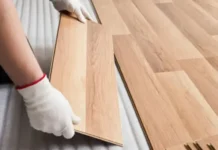The US faucet market was worth approximately $3.2 billion in 2020.
That shows how much money folks spend on these fixtures, considering they’re a must in all homes. Without them, there’s no way to control water flow from plumbing pipes.
More than that, faucets are essential to hygiene and sanitation. This is especially true for bathroom sink taps. After all, they’re the go-to for hand washing after heeding the call of nature.
For the same reason, you should know how to clean bathroom sink faucets the proper way. This guide will show you how, so be sure to keep reading.
Have a Quick Look at Your Faucet Manual
Before you start cleaning your bathroom sink faucet, check its user manual first. Yours may have specific care instructions, especially if it has a living finish. This coat develops a natural patina as it ages, which you may accidentally remove with soap.
Make a Gentle Cleaning Formula
If your bathroom sink tap doesn’t have a special finish, you can clean it with regular dish soap. Start by mixing two tablespoons of liquid dish soap with two cups of warm water. Then, for easier cleaning, you can transfer the solution to a spray bottle.
Please don’t use caustic soda, bleach, alcohol, or ammonia when cleaning your faucets. These strong chemicals can corrode your taps and may even damage the gaskets and cause a leak. Keep in mind that a tap with a leak rate of one drip per second can waste over 3,000 gallons of water within a year.
Use a Soft Cloth for a Gentle Scrub
Spray or moisten a regular cleaning cloth with your DIY solution. If you’re going to use a sponge, be sure it’s the cellulose kind and not the abrasive type. Abrasive sponges can scratch the faucet finish, which can then promote corrosion.
Next, wipe the handles and the spout with the soapy cloth, starting from the top and sliding down to the bottom. Make sure to apply only light pressure to avoid dislodging the faucet.
Do note that some types of bathroom faucets, such as the widespread kind, have separate parts. In widespread faucets, there are three: the left handle, the spout, and the right handle. Each component has its own installation hole, and thus, a separate seal.
If that’s the type of faucet you have, take extra care and be very gentle when cleaning each component. Too much pressure can damage the handle or spout seal, which, in turn, can lead to a leak.
Use an Old Toothbrush to Remove Grime and Deposits
You can use an old toothbrush to get rid of grime and deposits on the spout hole and faucet base. Sometimes, you may have to let these areas soak in soapy water for about a minute to soften the crusty deposits. After that, gently brush the hole and the base to dislodge the contaminants.
Rinse and Dry
Grab a bowl, fill it with cold water, and dunk a fresh piece of cloth in it. Next, wring the cloth and use it to rinse the entire faucet from the tip to the base. You may have to repeat this a few times to ensure no soap or gunk remains on your bathroom taps.
After rinsing, grab another sheet of clean, dry cloth to dry the faucet completely. Doing this right after the final rinse will help prevent water spots from forming on the finish.
Regularly Clean Bathroom Sink Faucets to Keep Tap Water Clean
Keep in mind that taps are high-touch surfaces, which is why they can harbor pathogens and molds. An early study even found faucet handles to be the second-dirtiest spot in bathrooms.
As such, failure to clean bathroom sink faucets can lead to water contamination. That’s enough reason to keep your taps, or better yet, your entire bathroom, clean and hygienic.
Interested in more home maintenance or even lifestyle and travel guides? Then feel free to have a look at our other informative blog posts!



































































